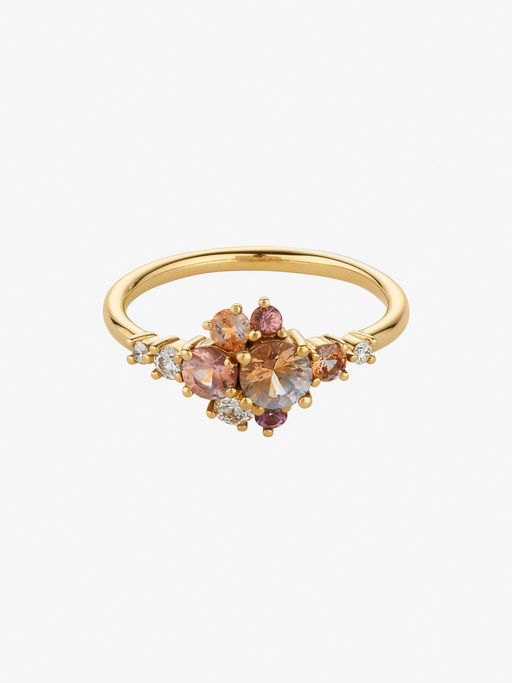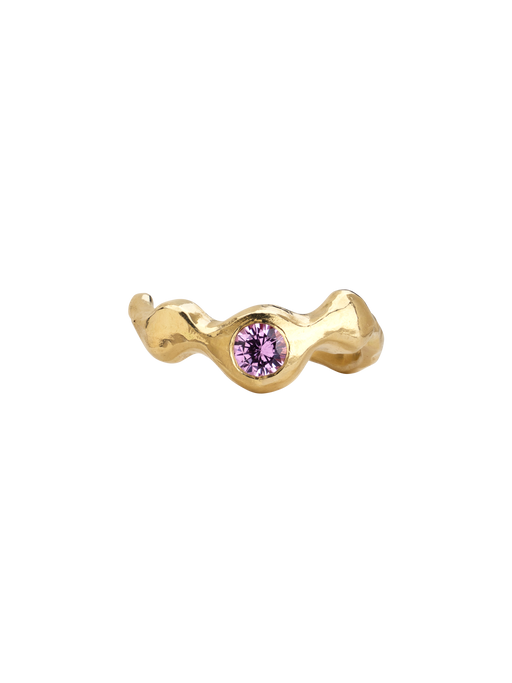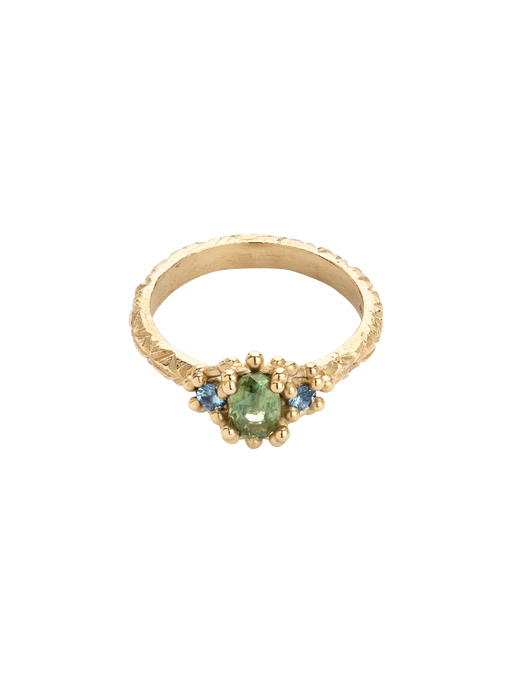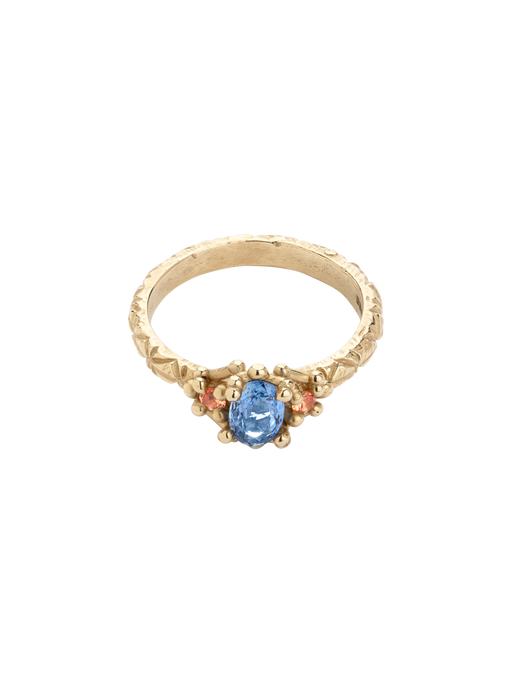Alternative gemstones for engagement rings

Engagement rings are meant to be worn everyday, but everyday wear can take a toll on your ring’s gemstones. While diamonds may be the stones most associated with engagement rings, they are not your only choice.
Diamond engagement rings
Dan Dower of Dower & Hall says: “People think of diamonds for engagements because the diamond industry is very, very good at promoting. Ever since DeBeers, everyone is aspiring to be a diamond Princess. It’s fascinating.
“There are a few alternatives. You’ve got your salt and pepper diamonds. But people tend to first time round tend to go for a white diamond.”
If you want a white diamond engagement ring, learn about the 4Cs. But white isn’t the only diamond colour you can get.
Salt and pepper diamonds are diamonds that have a lot of inclusions – “blemishes” – which gives the stone a unique pattern. One benefit of salt and pepper diamonds is the price: they are significantly cheaper than white diamonds.
You can also choose to have coloured diamonds, and the choices are endless. Their grading is different to white diamonds, so look for fancy light, fancy, fancy intense and fancy vivid diamonds if colour if what you want for your engagement ring.
Alternative gemstones for engagement rings
With diamonds out of the way, let’s look at some engagement rings’ alternatives.
Dan Dower says: “Sapphires are fantastic because they go with all sorts of things and you can tend to get a larger scale and more interesting designs, without the compromise on size.”
There are no real restrictions when it comes to engagement rings and stones. But jeweller Xiao Wang does have some tips: “I think in general, soft stones aren’t great for engagement rings. Anything under a hardness of seven, I think it's on the edge of maybe a little bit soft. I don't really recommend pearls or opals.
“Seven and above is good and many, many gemstones are 7 and above. That’s really a personal preference too. If you want something, I always say just have it. If you need to replace that stone in 10 years, fine.”
Xiao says that she would always lead with colour when it comes to diamond alternatives. “In terms of diamond alternatives, I always ask for colour preference.
“Most people do know what colours they like. Then I go from there and give options that I think are really great because the stones have good hardness, or they are tough and good for everyday wear.”

Engagement ring’s gemstones with hardness 7 and above
As Xiao mentions, many stones are rated 7 and above. The scale for stones’ hardness is called Mohs and measures the stone’s resistance to scratching.
Some popular alternatives for engagement rings include rubies and sapphires (hardness 9), topaz (hardness 8), and emeralds and aquamarines (hardness 7.5).
Morganites are a type of beryl and have a hardness of 7.5/8, while amethysts are still considered hard enough for everyday wear at 7.
Diamonds have a hardness of 10, so they are the “best” in terms of durability. A white stone alternative is white sapphire, which has a hardness of 9.
Alternative gemstones by colour
Our in-house gemmologist, Lezlie, has some great tips for alternative gemstones for engagement rings, taking into account both colour and durability.
Purple
Sapphire: With a hardness of 9, sapphires are “hardwearing, can withstand delicate settings, and are easy to look after.
To keep sapphires clean, Lezlie recommends “warm soapy water, soft toothbrush, cleaning cloth”. Sapphires are also “ultrasonic cleaners safe”.
Spinel: Like sapphire, spinel (hardness 8) is easy to look after and has the same recommendations for cleaning. Lezlie says: “spinel is hardwearing, has a good shade range, is more affordable than other stones and is easy to look after.”
Tanzanite: With a hardness of only 7, tanzanite is slightly softer and prone to scratches and chips.
While tanzanite is fairly easy to look after (warm soapy water, soft toothbrush, cleaning cloth), it isn’t ultrasonic safe, and you should keep it away from drastic changes in temperature.

Blue
Sapphire: Sapphire is not only hardwearing, it also has a good colour range (teal - light blue). The gemstone can also withstand delicate settings and is easy to look after.
Spinel: Another appearance from spinel, which can come in a range of blues, from pale to deep colours and is easy to look after.
Aquamarine: With a hardness of 7.5, aquamarine should be protected from scratches. Aquamarine is limited in colour range but good for those who like transparent lighter blues. It is also easy to look after with warm soapy water, soft toothbrush, cleaning cloth and is usually ultrasonic safe.
Green
Sapphire: There is one stone that Lezlie recommends for any colour you may want, and it’s sapphire. With a hardness of 9 and easy maintenance, the gemstone comes in all the colours of rainbow.
Emerald: With a hardness of 8, you’d think emerald would be easy to maintain, but Lezlie says it “requires lots of care if wearing everyday.
“It should be in a secure setting and kept away from other stones and metals. Emerald is very brittle so shapes with points (pear, marquise, etc.) should be avoided.
“Most emeralds will have inclusions so not ideal for those who prefer clean stones.”
Also to note, emerald is not ultrasonic safe.
Demantoid garnet: While demantoid garnet has a hardness of 7.5, it can withstand delicate settings and is good for those wanting a vivid green colour and interesting inclusions. It is also fairly easy to look after with warm soapy water, soft toothbrush, and a cleaning cloth. It is ultrasonic safe.
Yellow
Diamond: The hardest of gemstones with a perfect 10, diamond comes in a variety of yellow shades from pale to vivid. It is more expensive than most stones, but is easy to look after with warm soapy water, soft toothbrush and a cleaning cloth. It’s also usually ultrasonic safe.
Sapphire: Sapphire also comes in yellow, with the same recommendations as before: hardness of 9 and easy maintenance.
Heliodor: A good engagement ring alternative gemstone, heliodor has a hardness of 7.5. It should be protected from scratches and is limited in colour range. Lezlie says “it is good for those who like transparent, lighter yellows”. It’s easy to look after and usually ultrasonic safe.

Orange
Sapphire: Still the top recommendation from Lezlie, sapphire is a great orange gemstone for engagement rings.
Spinel: With a hardness of 8, spinel is hardwearing. It offers pale colours and is easy to look after.
Imperial Topaz: Another stone with a hardness of 8. However, Lezlie says it “isn’t very tough and prone to breaking if knocked or dropped. Avoid big temperature changes and long exposure to sunlight (which can change the colour of the stone).
To clean, use warm soapy water, soft toothbrush, and cleaning cloth. This stone is not ultrasonic safe.
Red
Ruby: Ruby is red sapphire, so the stone also has a hardness of 9, is hardwearing and can withstand delicate settings. Look after it as you would a sapphire, but not it is only ultrasonic safe if not treated.
Spinel: Spinel has a range of shades from dark red to vivid red and a hardness of 8. It’s also easy to look after and is ultrasonic safe.
Garnet: Lezlie recommends a garnet (hardness of 7.5) for those wanting darker reds with less pink tones. It’s easy to look after and ultrasonic safe.
Pink
Sapphire: Sapphire offers lots of pink shades to pick from.
Spinel: Another gemstone with many colour options for engagement rings is spinel. Spinel comes in a range of shades, from hot pink and purplish pink to pale pink.
Tourmaline: With its hardness of 7.5, tourmaline can withstand delicate settings, and offers a good range of tones and shades. It is easy to look after and is ultrasonic safe.
 Earn Credit
Earn Credit




.jpg?ixlib=gatsbyFP&auto=compress%2Cformat&fit=max&w=800&h=900)